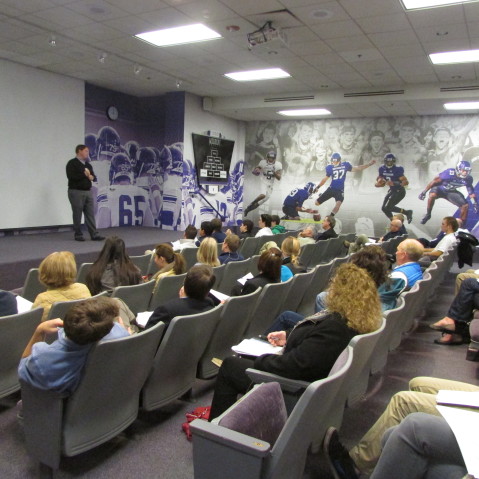The Wildcat Golf Academy hosted its first annual College Night. WGA co-founder and Northwestern’s Director of Golf Pat Goss, NU Women’s Golf Coach EmilyFletcher, and NU Assistant Coach David Inglis spoke to WGA members and their parents about a variety of topics including “What does is take to play golf?; How do I start the process of contacting coaches?; Is playing Division I a reality, and if not what are my other options?” Below is a synopsis of some of the questions/answers that were talked about during the evening.

What are coaches looking for when they are recruiting players?
- At the end of the day score is what matters.
- Do they know “how” to play the game, not just have a perfect swing,
- Will they transition well into college, for example do they know how to manage their time when they will be on their own for the first time.
- How well do they handle themselves on the golf course.
How do you know if a school is really interested in recruiting you?
- Hand-written, personalized letters from a coach are more meaningful than generic typed letters.
- Official visits (offered and paid for by a coach) are an indication that you are one of the school’s top 3-4 recruits among your graduating class.
- On-campus meetings with coaches held during an unofficial visit do not necessarily indicate that the coach is interested in recruiting you. Oftentimes, they are courtesy visits.
- Regular (at least weekly) email exchanges from the coaching staff insure that you are a serious recruit and that the coaches intend to maintain a dialogue with you throughout the recruiting process.
- Constant on-course playing evaluations at a tournament by members of a coaching staff indicate that you are a top recruit and that a scholarship offer is imminent.
- A courtesy reply letter from a school does not mean that you are on their recruit target list for your graduation class.
- An introductory letter and questionnaire sent to you as a sophomore indicates that you are one of 20-30 prospects on that coach’s recruiting list for your graduation class.
What is the difference between Division I, II or III?
- Approximately 30 percent of all college golf teams compete in NCAA Division I.
- The remaining programs are members of NCAA Division II, NCAA Division III, the NAIA (National Association of Intercollegiate Athletics), or the NJCAA (National Junior College Athletic Association). Many of these golf programs are highly competitive and offer student-athletes an excellent opportunity to compete in intercollegiate athletics during their college years.
- The main differences between Division II/III and Division I programs result from limited financial resources. The first sign of these limited resources is scholarship funding.
- The NCAA allows men’s Division II programs to award 3.6 full scholarships annually (vs. 4.5 in Division I) while women’s Division II programs can award 5.4 full scholarships annually (vs. 6.0 in Division I).
- Division III programs are prohibited from awarding any athletic scholarships. Also, Division II and Division III programs typically have smaller operating budgets (travel, equipment, facilities, etc.), and in many cases, the coaches have additional university responsibilities to supplement their coaching salaries.
- Scholarship and budget deficiencies for Division II and Division III programs are where the differences end.

